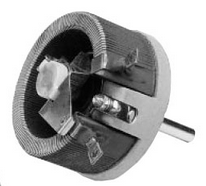The APR series of rheostat has a long history of reliable operation in many applications requiring a rugged, easily mounted rheostat that can offer variable resistance adjustment and high power ratings. Selecting the appropriate rheostat is a matter of determining the power that has to be ‘dropped’ across the rheostat winding and the required resistance of the rheostat.
Available Rheostat Power Ratings
The APR series has 5 available power ratings giving engineers flexibility in selecting the most  appropriate rating for their product or design. These ratings available are 25 watt, 50 watt, 150 watt, 300 watt and 500 watt. Power dissipation of the various models is achieved by means of the ceramic former that the resistance winding is wound on and the grade and gauge of the resistor wire employed in the rheostat. A 25 watt rated rheostat has a former diameter of 40mm compared to a 500 watt rheostat that has a ceramic former diameter of 198mm (data here).
appropriate rating for their product or design. These ratings available are 25 watt, 50 watt, 150 watt, 300 watt and 500 watt. Power dissipation of the various models is achieved by means of the ceramic former that the resistance winding is wound on and the grade and gauge of the resistor wire employed in the rheostat. A 25 watt rated rheostat has a former diameter of 40mm compared to a 500 watt rheostat that has a ceramic former diameter of 198mm (data here).
Irrigation Pump Example
Australia’s outback can offer a harsh environment for electrical and electronic equipment to function and reliability of any componentry used is of the utmost importance. A customer needed a 120 watt rheostat in an irrigation project that was to be located in the Northern territory. The required rheostat was used in conjunction with a 12 volt (d.c.) water pump system that pumped water from a remote dam via p.v.c. pipes to a cattle feed lot located some 2 kilometers away. Because of significant voltage drop in the wires that fed the water pump from an unregulated d.c. power supply it was found that a simple but very reliable solution to control the motor pump speed was achieved by means of an APR 150 rheostat (150 watt rating). The slight power over rating of the 150 watt rheostat ensured reliable operation and followed good design principles. The operator of the property was able to control the speed of the d.c. pump via the rheostat which meant that the flow of water could be regulated easily.
Simple Solutions Make Sense
Modern electronic design can offer complex solutions. In this case the control of a d.c. motor could well call for a pulse width modulated motor control design to control the speed of the d.c. pump. However the remotely located pump often experienced temperatures ranging from -10 C to +55 C which can potentially present challenges to electronic equipment. The rheostat solution was a simple, effective and very reliable solution as well as being cost effective.
